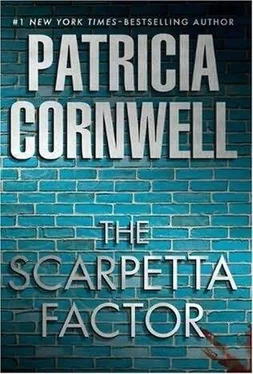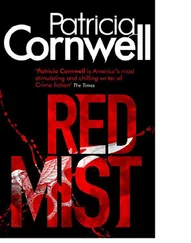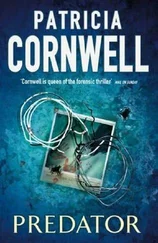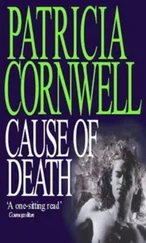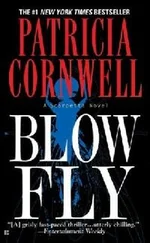“You work pro bono. I believe that’s been in the news-you donate your time to the New York office.” Carley turned to the camera. “For my viewers who might not know, let me explain that Dr. Kay Scarpetta is a medical examiner in Massachusetts and also works part-time, without pay, for the New York City ME ’s office.” To Scarpetta, “Not that I completely understand how you can work for New York City and the Commonwealth of Massachusetts.”
Scarpetta didn’t enlighten her.
Carley picked up a pencil as if she might take notes and said, “Dr. Scarpetta, the very fact that you say you can’t talk about Hannah Starr is because you believe she’s dead. If you didn’t believe she was dead, it wouldn’t be an issue for you to voice your opinion. She can’t be your case unless she’s dead.”
Not true. Forensic pathologists can, when needed, examine living patients or get involved in cases of missing persons who are presumed dead. Scarpetta wasn’t going to offer a clarification.
Instead she said, “It’s improper to discuss the details of any case that’s under investigation or hasn’t been adjudicated. What I agreed to do on your show tonight, Carley, was to have a general discussion about forensic evidence, specifically trace evidence, one of the most common types of which is the microscopic analysis of hair.”
“Good. Then let’s talk about trace evidence, about hair.” Tapping the pencil on paperwork. “Isn’t it a fact that tests done on hair could prove it was shed after someone was dead? If hair was discovered in a vehicle, for example, that had been used to transport a dead body?”
“DNA isn’t going to tell you someone is dead,” Scarpetta repeated.
“Then hypothetically, what could hair tell us, saying hair identified as Hannah’s was recovered from some location, such as a vehicle?”
“Why don’t we discuss microscopic hair examination in general. Since this is what you and I agreed we’d talk about tonight.”
“In general, then,” Carley said. “Tell us how you might be able to determine that hair is from a dead person. You find hair somewhere, let’s say inside a vehicle. How can you tell if the person who shed it was alive or dead at the time?”
“Postmortem root damage or lack of it can tell us if head hair was shed by a living person or a dead body,” Scarpetta answered.
“Precisely my point.” Tapping her pencil like a metronome. “Because according to my sources, there has been hair recovered in the Hannah Starr case, and it definitely showed evidence of the damage you would associate with death and decomposition.”
Scarpetta had no idea what Carley was talking about and wondered bizarrely if she might be confusing details of the Hannah Starr case with those from missing toddler Caylee Anthony, whose head hairs recovered from the family car trunk allegedly showed signs of decomposition.
“So, how do you explain hair damaged the way it gets after death if the person isn’t dead?” Carley nailed Scarpetta with a stare that looked perpetually startled.
“I don’t know what you mean by ‘damaged,’ ” Scarpetta said, and it crossed her mind she should walk off the set.
“Damaged by, let’s say insects, for example.” Carley tapped the pencil loudly. “Sources have informed me that hair found in the Hannah Starr case shows evidence of damage, the sort of damage you see after death.” To the camera, “And this hasn’t been released to the public yet. We’re discussing it for the first time right here, right now, on my show.”
“Insect damage doesn’t necessarily mean the person who shed hair is dead.” Scarpetta answered the question, avoiding the topic of Hannah Starr. “If you naturally shed hair in your home, in your car, in your garage, the hair can be and in fact likely will be damaged by insects.”
“Maybe you can explain to our viewers how insects damage hair.”
“They eat it. Microscopically, you can see the bite marks. If you find hair with evidence of this type of damage, you generally assume the hair wasn’t shed recently.”
“And you assume the person is dead.” Carley pointed the pencil at her.
“Based on that finding alone, no, you couldn’t draw that conclusion.”
In the monitors: microscopic images of two human head hairs magnified 50X.
“Okay, Dr. Scarpetta, we have pictures you asked us to show our viewers,” Carley announced. “Tell us exactly what we’re looking at.”
“Postmortem root banding,” Scarpetta explained. “Or, in the words of the eminent trace evidence examiner Nick Petraco, an opaque ellipsoidal band which appears to be composed of a collection of parallel elongated air spaces along the hair shaft nearest the scalp.”
“Whew, let’s translate for the viewers, how ’bout it.”
“In the photos you’re looking at, it’s the dark area at the bulb-shaped root. See the dark banding? Suffice it to say, this phenomenon doesn’t occur in living people.”
“And these are Hannah Starr’s hairs we’re looking at,” Carley said.
“No, they’re certainly not.” If she walked off the set, it would only make matters worse. Just get through this, Scarpetta told herself.
“No?” A dramatic pause. “Then whose are they?”
“I’m simply showing examples of what the microscopic analysis of hair can tell us,” Scarpetta answered, as if the question was reasonable, when it absolutely wasn’t. Carley knew damn well the hair wasn’t from the Hannah Starr case. She knew damn well the image was generic, was from a PowerPoint presentation Scarpetta routinely gave at medicolegal death investigation schools.
“They’re not Hannah’s hairs, and they’re not related to her disappearance?”
“They’re an example.”
“Well, I guess this is what they mean by ‘the Scarpetta Factor.’ You pull some trick out of your hat to support your theory, which clearly is that Hannah’s dead, which is why you’re showing us hairs shed by a dead person. Well, I agree, Dr. Scarpetta,” Carley said slowly and emphatically. “I believe Hannah Starr is dead. And I believe it’s possible what happened to her is connected to the jogger who was just brutally murdered in Central Park, Toni Darien.”
In the monitors: a photograph of Toni Darien in tight pants and a skimpy blouse, bowling lanes in the background; another photograph-this one of her body at the crime scene.
Where the hell did that come from? Scarpetta didn’t show her shock. How did Carley get her hands on a scene photograph?
“As we know,” Carley Crispin said to the camera, “I have my sources and can’t always go into detail about who they are, but I can verify the information. Suffice it to say, I have information that at least one witness has reported to the NYPD that Toni Darien’s body was seen being dragged out of a yellow cab early this morning, that apparently a taxi driver was pulling her body out of his yellow cab. Are you aware of this, Dr. Scarpetta?” To the slow tempo of pencil tap-taps.
“I’m not going to talk about the Toni Darien investigation, either.” Scarpetta tried not to get distracted by the scene photograph. It looked like one of the photos taken by an OCME medicolegal investigator this morning.
“What you’re saying is there’s something to talk about,” Carley said.
“I’m not saying that.”
“Let me remind everyone that Hannah Starr was last seen getting into a yellow taxi after she had dinner with friends in Greenwich Village the day before Thanksgiving. Dr. Scarpetta, you’re not going to talk about it, I know. But let me ask you something you should be able to answer. Isn’t part of the medical examiner’s mission prevention? Aren’t you supposed to figure out why somebody died so maybe you can prevent the same thing from happening to someone else?”
Читать дальше
